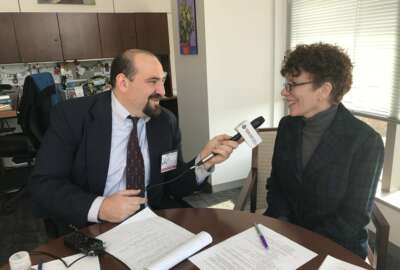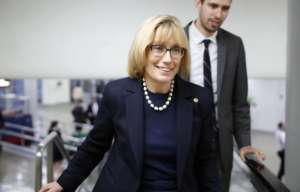

A lawmaker on the Homeland Security and Governmental Affairs Subcommittee on Federal Spending Oversight and Emergency Management, asked 10 agencies about each o...
Best listening experience is on Chrome, Firefox or Safari. Subscribe to Federal Drive’s daily audio interviews on Apple Podcasts or PodcastOne.
The door to solve some of the systemic issues plaguing federal IT modernization efforts opened slightly more over the last few months.
Many would agree that one of the few silver linings in the coronavirus pandemic has been the ability of agencies to upgrade network and security services in record time to accommodate the surge in remote working.
The second item to pry the door just a little bit wider came from Sen. Maggie Hassan (D-N.H.). The ranking member of the Homeland Security and Governmental Affairs Subcommittee on Federal Spending Oversight and Emergency Management wrote to 10 agencies on June 3 asking specific questions about each of their IT modernization strategies, systems in most need of modernization and, maybe the best signal of all, what Congress can do to help.

“Sen. Hassan sent the letters because of the particular impact legacy IT systems have had on COVID-19 relief efforts. Sen. Hassan looks forward to hearing back from agencies about their plans to modernize their technology,” said a subcommittee staff member. “Next steps — including potential additional funding from Congress to address legacy IT systems — will depend on what the senator hears back from agencies. Following up on Sen. Hassan’s questions to [Russ] Vought [the nominee to be OMB director], Sen. Hassan and her office will continue to be in touch with the Office of Management and Budget about the role it can play in modernizing federal IT.”
The fact that another lawmaker besides a few of the usual suspects — Reps. Gerry Connolly (D-Va.), Will Hurd, (R-Texas) and maybe a few others — gives the Trump administration an opportunity it has rarely had in the Senate over the last four years. The likelihood of getting bicameral support for funding that lasts longer than one year and addresses many of the shortcomings of the IT modernization efforts over the last 15 years is at least a little stronger.
“This is exactly what Congress should be doing to encourage agencies to bring government services into the 21st Century. Congressional oversight will be a critical driver in agency modernization plans and execution,” said Matt Cornelius, the executive director of the Alliance for Digital Innovation, an industry association, and a former OMB senior technology and cybersecurity advisor, in an email to Federal News Network. “We need more of this. Congress should be asking every agency probing questions, every year and in every appropriations hearing, about their plan to retire their most cumbersome and insecure legacy systems and what concrete steps they will take to ensure their agency is leveraging commercial capabilities to deliver an enhanced customer experience to citizens.”
The value of Hassan’s letters are not lost on the administration
Federal Chief Information Officer Suzette Kent said her office plans to work with agencies on their responses as well as with Hassan and others on Capitol Hill to address many of the long-standing IT modernization challenges.
“We’ve asked for application rationalization plans from agencies and many agencies have very good ones and other agencies still are developing pieces, and this will give some visibility to those,” Kent said in an interview. “In some cases, there were some things about modernization very generically and others had components that reflected on what happened in response to the crisis. Having to move quickly and do things differently has heightened the attention but also the importance to having modern technology that lets us be able to make those pivots, to move quickly and continue citizen services and mission continuity inside agencies.”
Kent said the application rationalization plans vary among agencies with some focused more broadly and others looking at particular high value systems or those with gaps or specific challenges.
“What the letters and the budget discussions will help us do is draw a more direct parallel between the business objective of the agency and how we fund those, and what the right vehicles are,” she said. “Particularly, the things that require multi-year commitment because some of the questions to the agencies focus on systems that were older or more comprehensive and those things don’t happen in a single year. That will let us have some healthy dialogue there as well as let agencies share their perspective around how they have prioritized what their modernization looks like, and that’s a dialogue that is very important agency by agency.”
Dave Powner, the former director of IT issues at the Government Accountability Office and now director of strategic engagement and partnerships for MITRE Corporation, said Hassan’s letters seem to focus on the 10 agencies that GAO highlighted its 2019 report on some of the oldest systems in government. This third report looked at 10 systems that were between 8 and 51 years old and critical to the respective agency’s mission.
“I think clearly when you look at what needs to be done, there needs to be more transparency on what needs to be done to replace these legacy systems. I think Sen. Hassan’s questions are on the spot,” Powner said. “These priority legacy initiatives need long term plans with clear accountability. I know it sounds like basic stuff but if you look at plans that need to be in place and why it’s so difficult to modernize these systems, that’s what’s missing many times.”
Powner said the GAO report also highlighted five legacy success stories and the reasons why those agencies were successful.
“They all took between 3 and 5 years, and when you look at the complexity with some of these mission modernization, there is tension between interrupting operations and modernization so there needs to be a plan that spans that timeframe,” he said. “You need to look at this not as something that will happen in six months, but something that will be a long-term effort with transparency and accountability.”
Powner said the combination of OMB and Congress performing the oversight is what makes modernization work best.
“If we brought back the watch or high risk list, which was something from the Bush administration that listed the top 30 or 50 mission modernization initiatives, that would be a good way to focus both Congress and the administration,” he said. “The question remains who is responsible — both the CIO and the mission or strategic business partners? Why are these things so difficult? It takes a long term focus from the business and the IT organization. So if Congress could help keep the eye on the ball for a longer period of time, along with OMB, that may be the right type of formula for success.”
Hassan recognizes that challenge as she asked for details about each agency’s implementation of the Federal IT Acquisition Reform Act (FITARA) and the role of the CFO when it comes to IT acquisitions.
Dan Chenok, a former OMB official and now executive director of the IBM Center for the Business of Government, said, Hassan’s interest is a positive development because whether it’s hearings or legislation or letters, it tends to lead to major changes in how the government manages technology.
“Most likely what she is trying to tease out are the systemic issues that agencies face with IT modernization. She probably will do some sort of crosscut view of key elements of modernization, where agencies are, how are they doing with cloud or with the adoption of open technologies, open standards and open source, and how are they doing introducing emerging technologies like artificial intelligence or blockchain or robotics process automation relative to the system’s important drivers of performance,” Chenok said. “I would think the end goal is to drive agencies toward better analytics where some of the modernization best practices can emerge.”
Chenok said every five to 10 years lawmakers come up with new legislation to help drive federal IT modernization and this may be the beginning of that next cycle.
OMB’s Kent said Hassan’s letter gives OMB another reason, another opening if you will, to discuss how to sustain agency transformation.
“There are things that we continue the dialogue around, like supporting agency requests for working capital funds, or when the budgets come in with specific modernization goals around projects or shared services, and understanding that these are not one and done projects. There needs to be an ongoing commitment to make real change,” she said. “We want to make sure that we continue the dialogue with improving the consistency and the clarity of results delivered. Whether that’s a dashboards, scorecards, project transparency, the way we tell mission stories, Congress asks for numbers and demonstrations of how value is being delivered, and agencies want to share that in a meaningful way that not only shows progress, but means something to taxpayers and the constituents being served.”
Copyright © 2024 Federal News Network. All rights reserved. This website is not intended for users located within the European Economic Area.
Jason Miller is executive editor of Federal News Network and directs news coverage on the people, policy and programs of the federal government.
Follow @jmillerWFED



